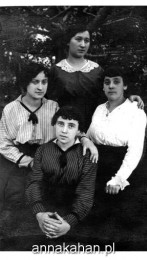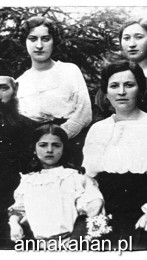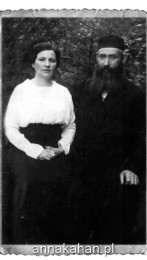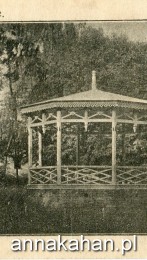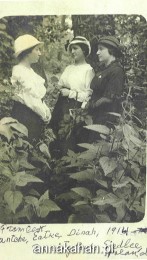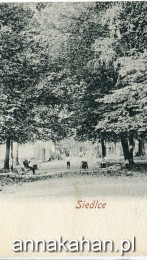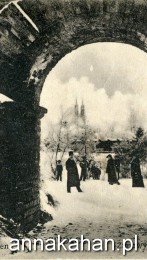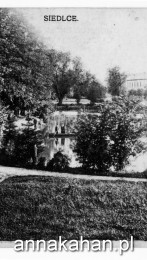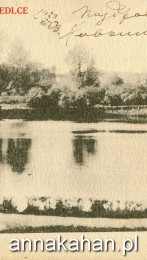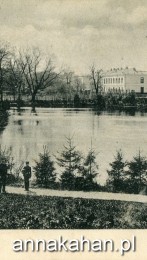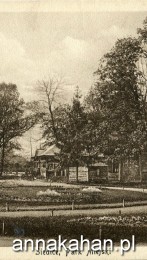[The City Park]
The city park which lies before us is called “Aleksandria” from the name of its founder the Duchess Aleksandra Ogińska.
The history of the park dates back to the 18th century, a time of growing popularity of English landscape gardens, which resulted in a certain kind of rivalry between members of Polish aristocracy. Although the park did not win the competition, as it lost to the “Arkadia” in Nieborów, it was equally attractive and interesting. Unfortunately, the present day “Aleksandria” park, though still charming, is but a shadow of its former glory and picturesque architecture in the Duchess’ time.
The park area decreased considerably during the partitions of Poland. In the early 20th century, most of the canals and ponds were filled in, and the picturesque bridges were dismantled. It is a great pity because in 1783, when the king Stanisław August Poniatowski visited the Duchess Aleksandra, his aunt, the place was outstanding. He took a gondola ride on the canals and then spent a while on the island. Only a Roman triumphal arch bridge has remained from around thirty elements of the park architecture built for the king’s visit.
In Anna Kahan’s time, and during the interwar period, the park entrance was situated in the same place as it is today – in front of the palace. The park was a leisure area for the residents of Siedlce mainly during summer Sundays as on that day the 22nd Infantry Regiment Orchestra gave concerts on a specially constructed stage.
In the park, you could also watch a film in an outdoor summer cinema, eat ice cream or drink lemonade. During the winter, many residents of Siedlce enjoyed ice skating at the park ice rink. Everyone moved to the side as Maria Żyburowa and her husband Adam entered the ice rink. They were the best ice skating couple in the city.
For Jews, Sunday was the first day of the working week and a day of doing small business. This is how Christians and Jews coexisted in the past in Siedlce.
Anna Kahan very often worked more than twelve hours a day. In her free time, she enjoyed reading books and walking in the park. Frequently, she combined these two pleasures. She had her favourite places in the park. One of them was a bench on the square located on the left side near the entrance to the park. In the last month of the partitions, specifically on July 24, 1915, she described the place as her hideaway and her retreat. It was a Saturday, which for her was also a working day. Therefore, we can read that,
“I went early to the park so that I could read my book, Jealousy by Artsybashev. I sit on my favorite bench, which stands between two old trees whose branches overhang this spot, forming a sort of retreat.”
In the park, she felt free and relaxed. Often early in the morning, before work, she would meet with her friend, Itka. There was no one there at that time, so the girls could not only walk but also sing freely. They felt light and carefree.
Her notes show her sensitivity to the nature and landscape changes depending on the season and the time of day. Even though there are not many reflections on the beauty of the park’s natural environment, those that there are, are visibly related to the current mood of the Diary’s author. For example, in January, she recalled the smell of lilies and acacias because she was waiting for the spring and her pre-work walks in the park, which she called her “May day picnics.”
Fascinated with literature, she read books in the original, in several languages. She liked to discuss the book’s characters with her girlfriends. Often she walked in a group and then they discussed the books in pairs. From her notes between June 10 and 20, 1915, we know that she also listened to music,
“We meet Itke and Mindl on Warsaw Street and together we go to the park. On the raised platform a band is playing. How beautiful! It just lifts you off the ground.
We sit across the bandstand and listen. Throngs of strollers pass by. (…) The music calls, sings, weeps. It seems to me that everyone finds in it just what he feels. “
And then,
“At night, after work, we go to the park. It’s a lovely night. Strains of music and singing from the summer theater fill the air. There is life and joy all around me (…).”
In case of sudden rain, the strollers could find shelter under the veranda roof of the aforementioned summer theatre. It was a wooden building, located opposite the current entrance to the area near the Public Gymnasium No. 1 in Siedlce (secondary school). On April 17, 1915, Anna recalls,
“Suddenly, it starts raining. What a scene! From all directions people are running for shelter under the roof of the summer theater. The rain is increasing, the tree branches are bending and swaying under the attack. It suddenly turns pitch dark. All is dismal and deserted expect for this veranda full of laughing, shouting people. It seems to me that we are afloat on a ship in the middle of a dark ocean.
Gradually the rain and wind diminish. Someone puts out a hand like Noah with the dove. It gets lighter. The bold ones leave, others wait for the rain to cease entirely.”
The name “summer theatre” is slightly misleading, since the theatre plays were also performed there in the winter. We know this from, for example, Anna Kahan’s note from Friday, January 29, 1915. According to her personal opinion, there was a good play presented on that day.
It happened often that she was resting and relaxing in the park twice a day: before the work and after the evening meal. As she claimed, “Where else can you go?” The park was the centre of the cultural and social life of the city.
If her friends did not come across her in the park, they knew that something bad must have happened. A note from June 21, 1915 reflects how difficult for the residents of Siedlce were the last days under Russian rule, in the atmosphere of the already ongoing war,
“Great excitement was created by the sudden decree of a curfew. No one is permitted to be outside after 10 o’clock at night.
We leave the store at nine, go to the park for a half hour and then-home. What a weird picture! The stores are closed, lights are out and the streets are empty.”
Leaving the park, we go through the enclosed area directly adjacent to the palace.

